Peltophryne fluviatica, also known as the Dominican Caribbean toad or Hispaniolan crestless toad, is a species of toad endemic to the Cibao Valley in the northwestern Dominican Republic. It has only been recorded at two localities.
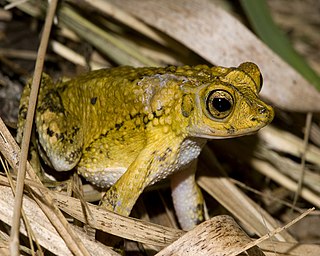
The Puerto Rican crested toad, or simply Puerto Rican toad, is a species of toad found only in Puerto Rico and the Virgin Islands. It is the only species of toad native to Puerto Rico and the Virgin Islands. The species formerly occurred in Virgin Gorda and along the southern and northern karst in Puerto Rico. It is listed as a threatened by the US Fish and Wildlife Service due to habitat loss and introduced species. At one period of time it was believed to be extinct until it was rediscovered in 1966. The IUCN has the species listed as endangered.
Bombina microdeladigitora is a species of toad in the family Bombinatoridae endemic to Guangxi, Hubei and Sichuan in China. It is commonly known by several names including Guangxi firebelly toad, Hubei firebelly toad, large-spined bell toad, Lichuan bell toad, small-webbed bell toad, and Yunnan firebelly toad. Its natural habitats are subtropical or tropical moist montane forests, temperate forests, rivers, swamps, and freshwater marshes. It is threatened by habitat loss.
The Cuban pine toad, or Schwartz's Caribbean toad, is a species of toad in the family Bufonidae. It is endemic to Cuba and found in western Cuba and on the Isla de la Juventud, below 70 m (230 ft) above sea level. Its natural habitats are savannas with pinewood, palms, and sandy soils. Breeding takes place in temporary pools, flooded pastures, and other shallow bodies of standing water; it can be abundant at breeding aggregations, but is otherwise hard to see. It is threatened by habitat loss caused by agriculture and sand extraction. Its habitat is also threatened by the invasive tree, Dichrostachys cinerea.
Nannophryne cophotis, or the Paramo toad, is a species of toad in the family Bufonidae that is endemic to northern Peru. Its natural habitats are puna grassland, high-altitude plateaus, and dry scrubland; it also occurs agricultural land. It breeds in temporary small ponds and permanent shallow streams at altitudes of 2000-4100 meters asl. Individuals have not been recorded since 2005, after what was believed to be a severe decline in its population. It was last known from: Granja Porcón & El Empalme (1999-2000); La Libertad (2003); Ancash (2004); and Cajamarca (2005). If a population exists it is believed to have 0-49 individuals remaining threatened from loss of habitat, pollution, conversion of land for farming, small and large-scale mining concessions, and the modification of waterways.
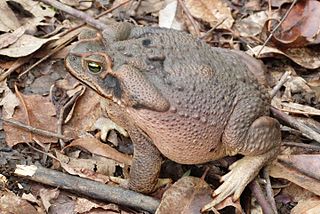
Rhinella diptycha, sometimes referred to as Cope's toad, Schneider's toad, cururu toad, or rococo toad, is a toad found in northern Argentina, Paraguay, Uruguay, eastern Bolivia, and eastern and southern Brazil. It is one of three rather similar species sometimes referred to as "cururu toads" in Brazil, the others being R. jimi and R. marina. Like those, R. diptycha is a large toad, females up to 25 cm (9.8 in) in snout–to–vent length and males up to 18 cm (7.1 in).
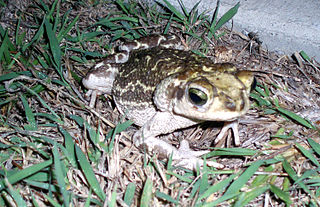
The Cuban small-eared toad, also known as the Cuban toad or Cope's Caribbean toad, is a species of toad in the family Bufonidae that is endemic to Cuba including Isla de Juventud.

The western giant toad is a species of toad in the family Bufonidae that is endemic to western Cuba. It occurs in a range of habitats including broadleaf forest, grassland, savanna, and agricultural areas. It is a common species but it can be locally threatened by habitat loss.
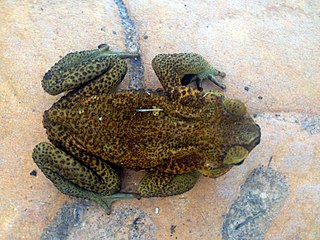
Peltophryne guentheri, the southern crested toad or Gunther's Caribbean toad, is a species of toad in the family Bufonidae. It is endemic to Hispaniola and found in the lowlands of Haiti and the Dominican Republic.
The Cuban high-crested toad, or Gundlach's Caribbean toad, is a species of toad in the family Bufonidae that is endemic to Cuba. It is found plains in all provinces as well as Isla de la Juventud and the Sabana-Camagüey Archipelago. The specific name gundlachi honors Johannes Christoph Gundlach, a German zoologist. Its natural habitats are primarily forests but also xeric and mesic grasslands. It is an explosive breeder of rain-flooded pools. It is threatened by habitat loss and degradation caused by agriculture, and by agricultural pollution. Its habitat is also threatened by the invasive tree Dichrostachys cinerea.

The Amargosa toad is a species of toad in the family Bufonidae. It was at one time considered to be a subspecies of the western toad. It is threatened by habitat loss and is classified by the IUCN as being "Critically endangered".

The western leopard toad is a species of toad in the family Bufonidae. The species is endemic to the low-lying areas of the Cape Peninsula, the Cape Flats and the Agulhas flats of the Western Cape, South Africa.

Peltophryne peltocephala is a species of toad in the family Bufonidae. It is endemic to Cuba and found in central and eastern Cuba as well as on some outlying islands. It occurs in a range of habitats including broadleaf forest, grassland, savanna, and agricultural areas. It is a common species but locally threatened by habitat loss.

The Cuban spotted toad, or Cuban Caribbean toad, is a species of toad in the family Bufonidae. It is endemic to central and eastern Cuba. Its natural habitats are lowland mesic broadleaf forests, but it also occurs on cultivated fields as long as they are not too intensively farmed. It is common in suitable habitat but its distribution is severely fragmented and its habitat is threatened by intensive agriculture, charcoaling, and nickel mining.

The little horned toad, also known as the dwarf horned toad, Kwangshien spadefoot toad, or tiny spadefoot toad, is a species of frog in the family Megophryidae. It is found in southern China, Thailand, Vietnam, and possibly in Laos and Myanmar. It has recently been reported from Bhutan. Its natural habitats are subtropical or tropical moist lowland forests, subtropical or tropical moist montane forests, rivers, and swamps. It is threatened by habitat loss.

Kaloula rugifera, the Sichuan digging frog or Szechwan narrowmouth toad, is a species of frog in the family Microhylidae found in China.
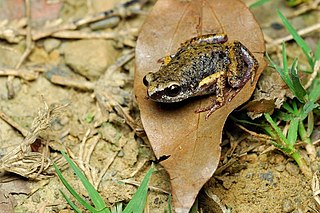
Micryletta steinegeri is a species of frog in the family Microhylidae. It is endemic to central and southern Taiwan. In the past it has also been considered as a synonym of Micryletta inornata from continental Asia.
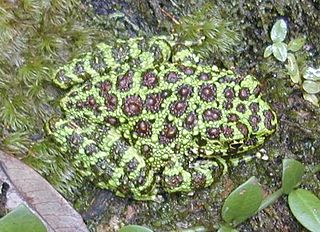
Ishikawa's frog is a species of frog in the family Ranidae. It is endemic to Okinawa Island, one of the Ryukyu Islands of Japan. It has been described as the most beautiful frog in Japan.
Taruga longinasus is a species of frog in the family Rhacophoridae. It is endemic to Sri Lanka.

Peltophryne is a genus of true toads in the family Bufonidae, from the Greater Antilles. With ten endemic species, Cuba hosts the highest diversity. Hispaniola has three endemics and Puerto Rico and the Virgin Islands combined has one.













